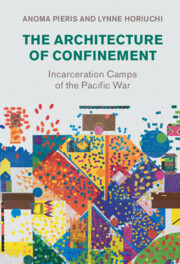14 results
Index
-
- Book:
- The Architecture of Confinement
- Published online:
- 17 February 2022
- Print publication:
- 24 February 2022, pp 358-374
-
- Chapter
- Export citation
8 - Prison City
-
-
- Book:
- The Architecture of Confinement
- Published online:
- 17 February 2022
- Print publication:
- 24 February 2022, pp 234-266
-
- Chapter
- Export citation
Contents
-
- Book:
- The Architecture of Confinement
- Published online:
- 17 February 2022
- Print publication:
- 24 February 2022, pp v-vi
-
- Chapter
- Export citation
Acknowledgments
-
- Book:
- The Architecture of Confinement
- Published online:
- 17 February 2022
- Print publication:
- 24 February 2022, pp xvii-xx
-
- Chapter
- Export citation
Introduction
-
-
- Book:
- The Architecture of Confinement
- Published online:
- 17 February 2022
- Print publication:
- 24 February 2022, pp 1-14
-
- Chapter
- Export citation
Tables
-
- Book:
- The Architecture of Confinement
- Published online:
- 17 February 2022
- Print publication:
- 24 February 2022, pp xiv-xiv
-
- Chapter
- Export citation
Abbreviations
-
- Book:
- The Architecture of Confinement
- Published online:
- 17 February 2022
- Print publication:
- 24 February 2022, pp xxi-xxii
-
- Chapter
- Export citation
Figures
-
- Book:
- The Architecture of Confinement
- Published online:
- 17 February 2022
- Print publication:
- 24 February 2022, pp vii-xi
-
- Chapter
- Export citation
Copyright page
-
- Book:
- The Architecture of Confinement
- Published online:
- 17 February 2022
- Print publication:
- 24 February 2022, pp iv-iv
-
- Chapter
- Export citation
Preface
-
- Book:
- The Architecture of Confinement
- Published online:
- 17 February 2022
- Print publication:
- 24 February 2022, pp xv-xvi
-
- Chapter
- Export citation
Maps
-
- Book:
- The Architecture of Confinement
- Published online:
- 17 February 2022
- Print publication:
- 24 February 2022, pp xii-xiii
-
- Chapter
- Export citation
Select Bibliography
-
- Book:
- The Architecture of Confinement
- Published online:
- 17 February 2022
- Print publication:
- 24 February 2022, pp 340-357
-
- Chapter
- Export citation
9 - Recovery, Redress and Commemoration
-
-
- Book:
- The Architecture of Confinement
- Published online:
- 17 February 2022
- Print publication:
- 24 February 2022, pp 267-289
-
- Chapter
- Export citation

The Architecture of Confinement
- Incarceration Camps of the Pacific War
-
- Published online:
- 17 February 2022
- Print publication:
- 24 February 2022



